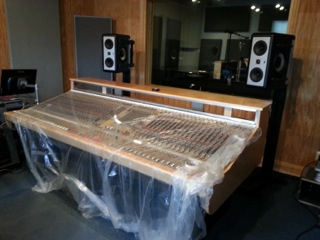
After settling in to an upward trend in studio business, I started to think about what would give the studio an edge. The C7 was a good start, but nobody in the area had a good analog console. I started researching the classic boards, like Neve, API, Studer, Sony/MCI. But what was a Cadac?
Clive Green started Cadac in 1968 in the UK. Although they did build studio consoles, they are best known for theater sound and have done long runs on shows such as The Lion King, Phantom of the Opera, Jersey Boys, Mama Mia, and countless others on Broadway as well as in London's West End. Andrew Lloyd Webber had a long relationship with Cadac, and his desire for studio quality sound on his live productions helped give rise to the console I ended up with; the "J-Type." The more I read about this console, the more interested I became, especially after chatting with others on certain pro audio blogs who have actually used these boards. Through the blogs I met a gentleman who had one in his studio, and informed me he could "put one together" for me. I was interested.
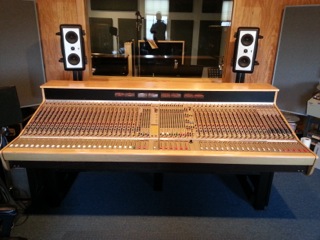
I gassed up my Subaru and made the trip. What I saw and heard was an extremely clean console, with a great preamp, excellent British EQ, and a clean signal path. This thing was heavy and built like a tank. The two rack-mounted power supplies were in the next room with very noisy fans. We pulled a module and I saw no expenses were spared. Lots of gold contacts, Vishay pots, P&G faders, tantalum capacitors; all good stuff. The copper traces were heavy. The circuit boards were green glass epoxy. The frame was very heavy steel. When I was quoted a price, I was sold on the spot. I was promised delivery of a 48-frame in two months, including one day of initial setup.
I went home and put my Digidesign Control 24 on eBay.
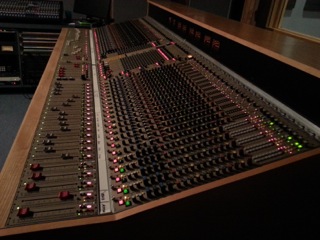
A few weeks later I got a call from the seller and he told me he found a 52-slot J-Type (instead of the 48) for the same price and delivery time. Fine with me. A few days later the phone rang again and I was informed a 52-frame was available for the same price, and would I mind adding two more stereo inputs to the proposed three stereo inputs. No brainer there.
On one cold January morning a U-Haul truck pulled into my driveway. It was very overcast. The console weighed 954 pounds and I had five men there to move it into the control room and on to a heavy duty five-legged stand that I spent a week building after getting dimensions and weight. The board came in a huge road case that I could probably fit my grand piano into, but it's wheels made the move easy. We lifted this behemoth onto its new stand, where it would begin a second life.
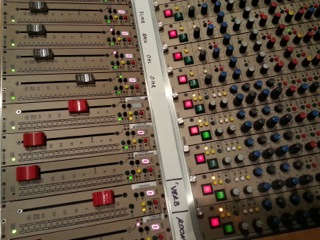
I have never heard a live console with such a low noise floor... period! And the preamp is transformerless, providing excellent transient response to balance out the analog warmth. The EQ is a 3-band, with top and bottom bands switchable to shelf or parametric. Adjustable hi-pass. What I loved was the individual bypass on each EQ section as well as the high pass, making minimal op amp routing possible. The input modules are assignable to 16 busses and 12 aux sends. The modules are hot-swappable, making repairs fast and easy without a shutdown. Just unplug the module's rear XLR connections and pull it right in the session. Also, this is the only console I know of where you can put modules anywhere you want on the universal frame. For example, I can configure it with 16 input modules followed by 4 groups, 12 more inputs, 6 groups, aux module and so forth.
But it's a live board, so what are the drawbacks? Let's start a:
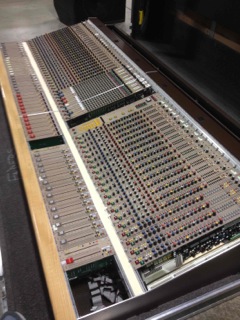
No real "stereo out." My console was configured with 8 group outputs and 8 (stereo) matrix outputs. I am currently using groups 1 & 2 as my stereo bus. I am designing (already have the parts) a stereo summing/output module using the API 2550 module with a P&G stereo fader. I plan on switching the 1/2 bus between the Cadac summing amps and my new stereo out, allowing two "flavors." There was no "control room monitor" level control on the "J". Solution: I built a passive monitor panel with Goldline 1 db per step 4-wafer attenuator and a Grayhill 4-pole source selector switch, which is mounted in a blank Cadac plate in the fader bay fed from a 5-position Grayhill selector switch. The PFL bus goes right to a headphone amp since there is no "monitor" module, but I found the DC signal on a multi-pin connector on the rear of the frame and built a circuit with some high quality mercury wetted relays to put a line-level PFL signal to my Barefoot MM27s while muting the program feed to them. No metering on the mains. Although I loved the LED metering right beside every fader, including the stereo ones, I missed larger metering on the main/bus outputs. I acquired four pairs of Dorrough 12-A program LED meters and wired them to my group outputs. And speaking of meters, this console had no meter bridge, so we had to build one. I hired a carpenter to match the finished maple wood arm rest and make matching console "sides" along with a low profile meter bridge. I then fabricated an aluminum panel to fit into the bridge and hold the meters. We then had this panel powder coated in a matte black finish. No built-in talkback. For talkback I mounted an illuminated IFB switch in another blank Cadac plate in the fader bridge, which I tied into my new PFL circuitry adding an adjustable "DIM" function when routing my PZM talkback mic into the Aviom cue system. The dual power supplies were very noisy (cooling fans) so I located them in a finished basement at the end of a custom 90-meter (extremely heavy) cable, which the seller "threw in" with the deal. I lucked out by getting the "switching" type power supplies (newer) rather than the ones with huge and heavy toroidal transformers. I think these run cooler and are more efficient. My son helped me pull the extremely heavy power supply cable through walls and across the control room ceiling.
The last touch was bringing all the ins and outs to (6) 1/4" patch panels, for convenience and flexibility. This was about three weeks of evening wiring.
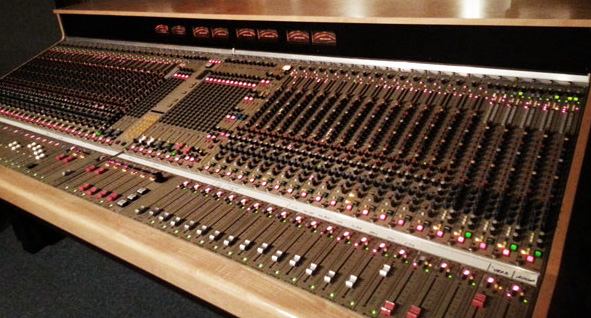
I did my first session on the console with a smooth jazz quartet, and I decided to use all Cadac preamps rather than my outboard Neves and Focusrites. I was absolutely thrilled! The drums were huge. The band noticed this immediately. The Fender Rhodes piano was silky, the guitar had a nice bite and the bass had a rock-solid bottom with push. The EQ was very responsive. We routed the first 10 aux sends pre-fader into the Aviom cue system so musicians basically could mix anything they wanted. There were no cue system brawls.
Maintenance and repairs? I grew up servicing large format consoles at studios I worked at... bring it on! The seller was able to locate a universal extender card for $75.
Now what you've all been waiting for. How much? The console itself was $4,000. I spent $1,100 on carpentry services. I obtained the Dorrough meters, which were broken, from a corporate client who was ready to throw them away and I obtained parts directly from Dorrough. Two nights on the workbench and I had eight working and calibrated meters... almost free! While I was at this same company I found a lot of snake cable laying around, pulled from a machine room that went all AES digital. One man's loss was once again another man's gain. I spent $82 at Home Depot on 4x4s and other lumber to build the stand, which I customized to put the faders 31 inches off the floor. So basically I invested a lot of sweat equity, or labor of love if you will. The aluminum meter bridge, including powder coating, was about $150. Let's add it up. For $5,407 (or less than you might expect to pay for a pair of Neve 1073 modules) I have a dream console that packs an incredible sound as well as more than enough wow-factor for potential clients. I have had no failures since it's installation.
Whenever I sit at this console I am a very happy man.





